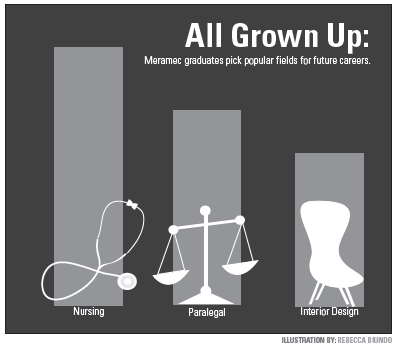STLCC graduates start early in preparing for prospective occupations
 By: DENNIS W. PARKS
By: DENNIS W. PARKS
Staff Writer
By: SPENCER GLEASON
Editor-in-Chief
To college students, the uncertainty of life after college is perhaps the only thing worse than taking college final exams. Whether graduation is in December or May, the future may seem hazy until that first regular paycheck from a real job comes along. While that first job most likely will not be the only job during a person’s career, it can be the hardest to find, making proper preparation very important.
Rita Reinhardt, a career specialist in the Career and Employment Services at STLCC-Meramec since 2008, said preparation is vital to success in the job market.
“To me preparation starts the moment you decide you want to go to school. One of the misconceptions is that they’ll wait until they graduate. Unfortunately, that pushes you behind the game plan,” Reinhardt said. “There are other people who are just as prepared as you, so you want to start very early on. You want to start connecting with employers or thinking about employers that you want to work with.”
It is also critical to continue researching possible career paths through college to determine if a chosen field is continuing to show growth or if recent graduates have already flooded the job market.
While changing majors can result in being required to take more classes to graduate, that may still be a better option than graduating with an obsolete degree in a dying market.
According to the U.S. Department of Labor’s Bureau of Labor Statistics, the occupations with the largest projected growth through 2020 are in the healthcare industry.
Of those, the top three in projected growth are as Personal Care Aides at 70.5 percent growth, Home Health Aides at 69.4 percent and Medical Secretaries at 41.3 percent.
While these professions are not at the top of the pay scale with median annual wages of $19,640, $20,560 and $30,530 respectively, according to the Bureau of Labor Statistics, there is projected growth potential.
With one foot in the healthcare industry, a degree in hand and a willingness to pursue additional training, the healthcare industry can lead to opportunities for Meramec graduates. Meramec alumna Sharon Rohrbach began her career as a registered nurse and eventually founded and became the CEO of the Nurses for Newborns Foundation.
According to Reinhardt, the nursing and physical assistance health care programs graduate a significant number of students at Meramec. “In 2011, there were 72 nursing students out of our 440 graduates. The bulk of our students were nursing. In second, was the paralegal studies, which is the paralegal department. After that was interior design with 28. Then, the physical therapy assistance program with 24 students,” Reinhardt said. “If you add up the nursing and physical therapy assistance program, they were quite a bit of graduates here at Meramec.
For those who prefer to work outdoors, three additional job classifications are expected to show growth of around 20 percent, according to the Bureau of Labor Statistics: construction laborers, landscapers, groundskeepers and heavy and tractor-trailer truck drivers. Median annual wages for these occupations are listed as $29,280, $23,400 and $37,770 respectively.
Among the Bureau of Labor Statistics’ occupations with largest job growth, the top two in terms of median annual wage are classified as physicians and surgeons at $111,570 and as registered nurses at $64,690; followed by accountants and auditors at $61,690. These higher paying careers are expected to grow at 24.4 percent, 26.0 percent and 15.7 percent respectively.
Whether graduation is just around the corner or post-secondary studies have just begun, consult with Meramec’s counseling department, located in the Administration Building/Clark Hall AD202. This free resource for students provides a guide to job types, the education and training required, typical responsibilities and the expected salary.
“We’ll definitely help walk you through some of the steps,” Reinhardt said. “We will help you with your professional documents, thinking about ways of researching and leading you to the resources. We’re pretty much here as your ‘Jimmy the Cricket’ — your conscience to help guide you through the job search process.”
Reinhardt said the service is valuable for students at every stage of the job search. “When I was in college, I didn’t know about career services. I didn’t utilize it like I should have,” Reinhardt said. “Take advantage of any of the services. Not only here, but if you move on to a different facility. See what is available to you as a student. It’s almost like you have a library card or gym membership. The chances are high that you’ll utilize those services.”










